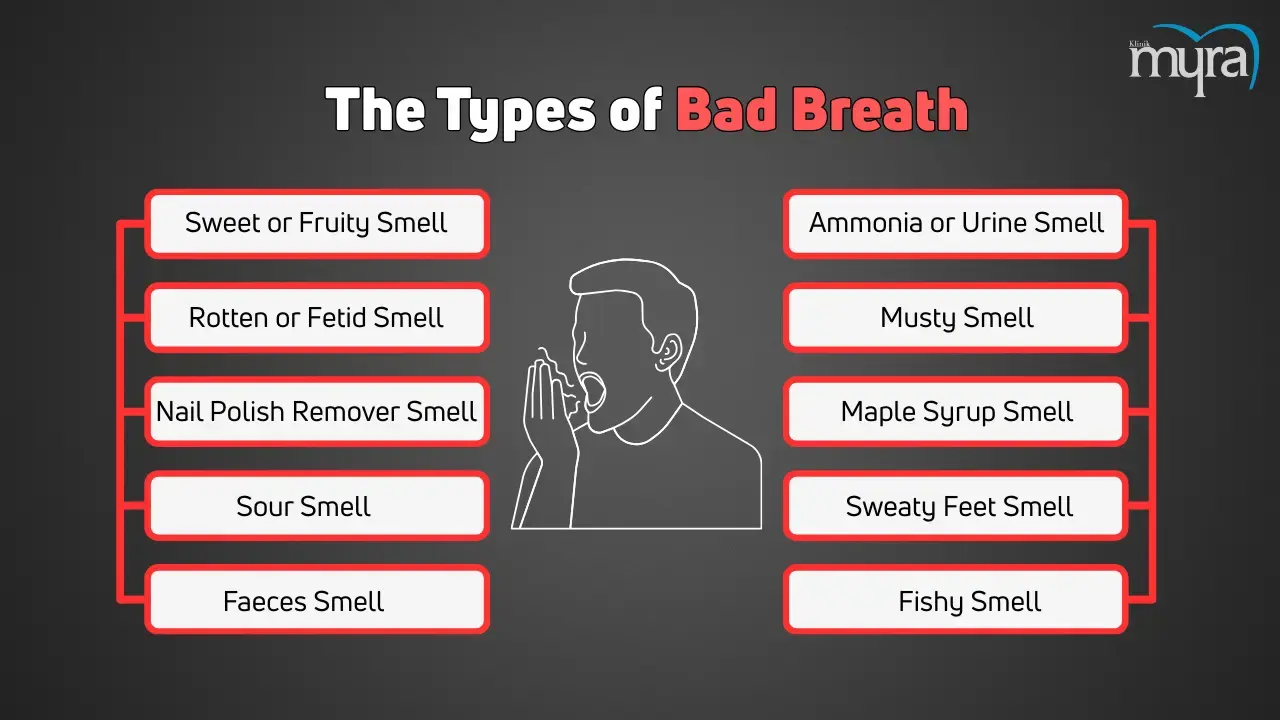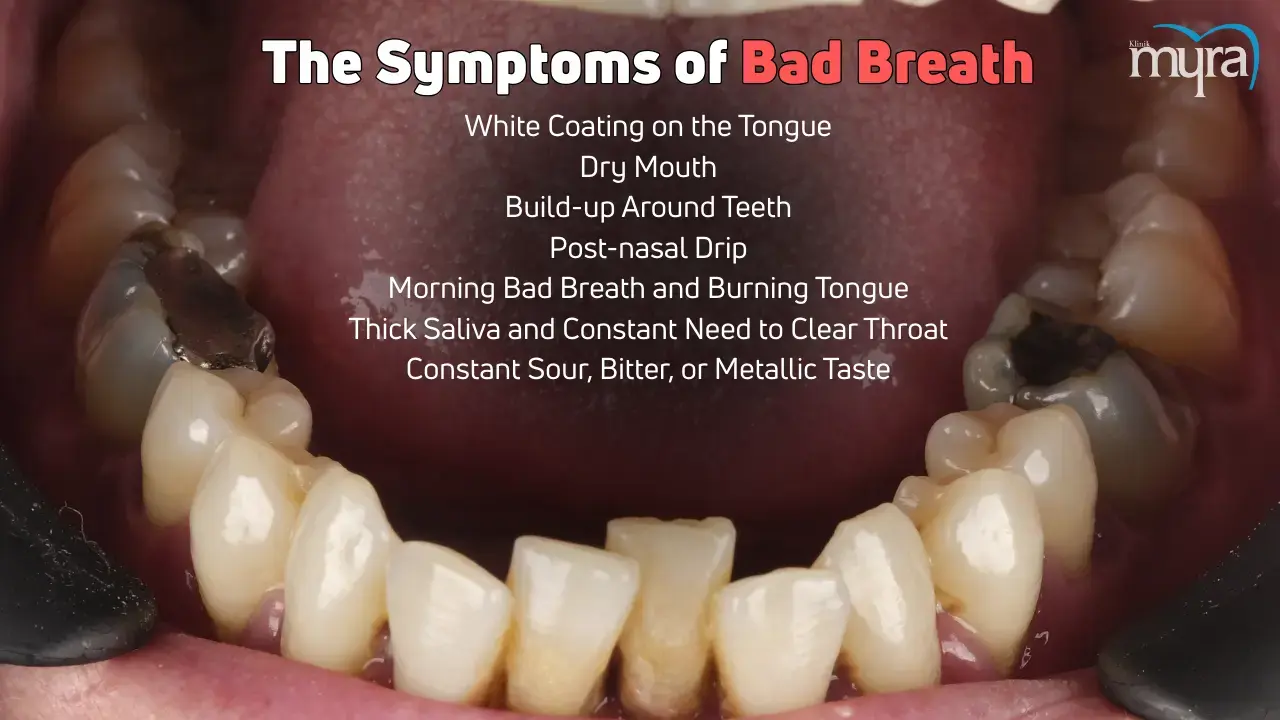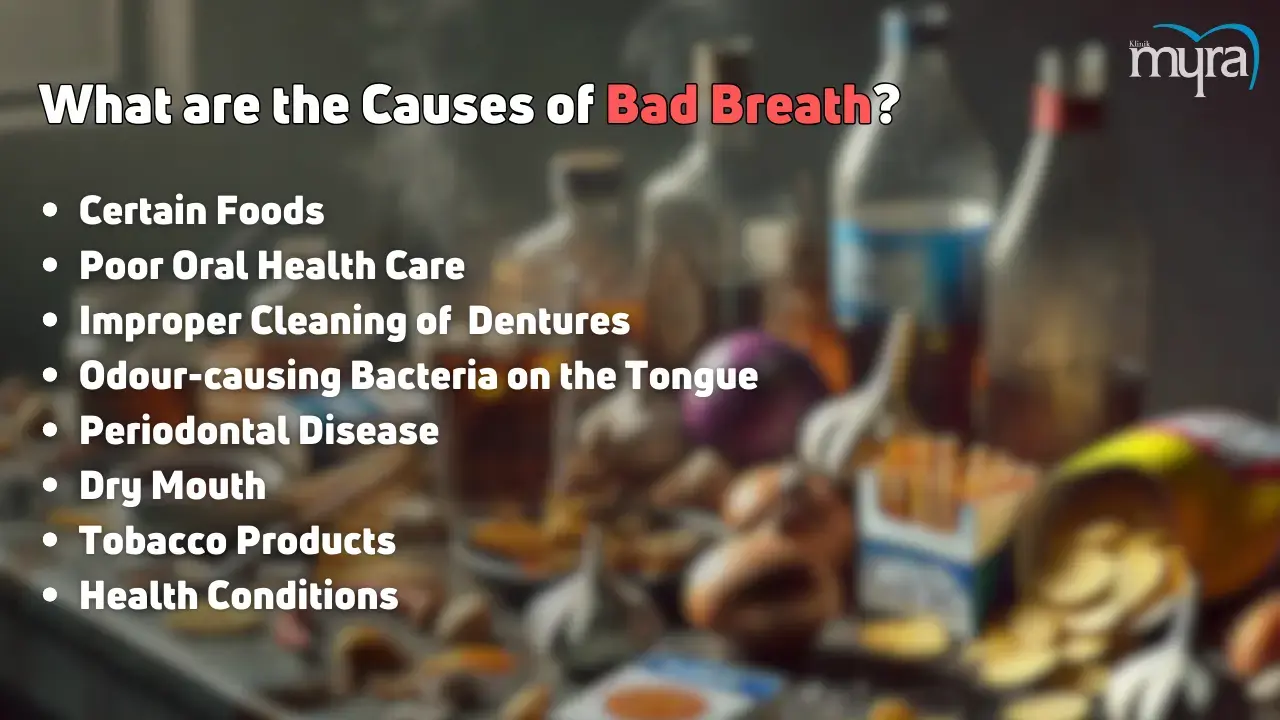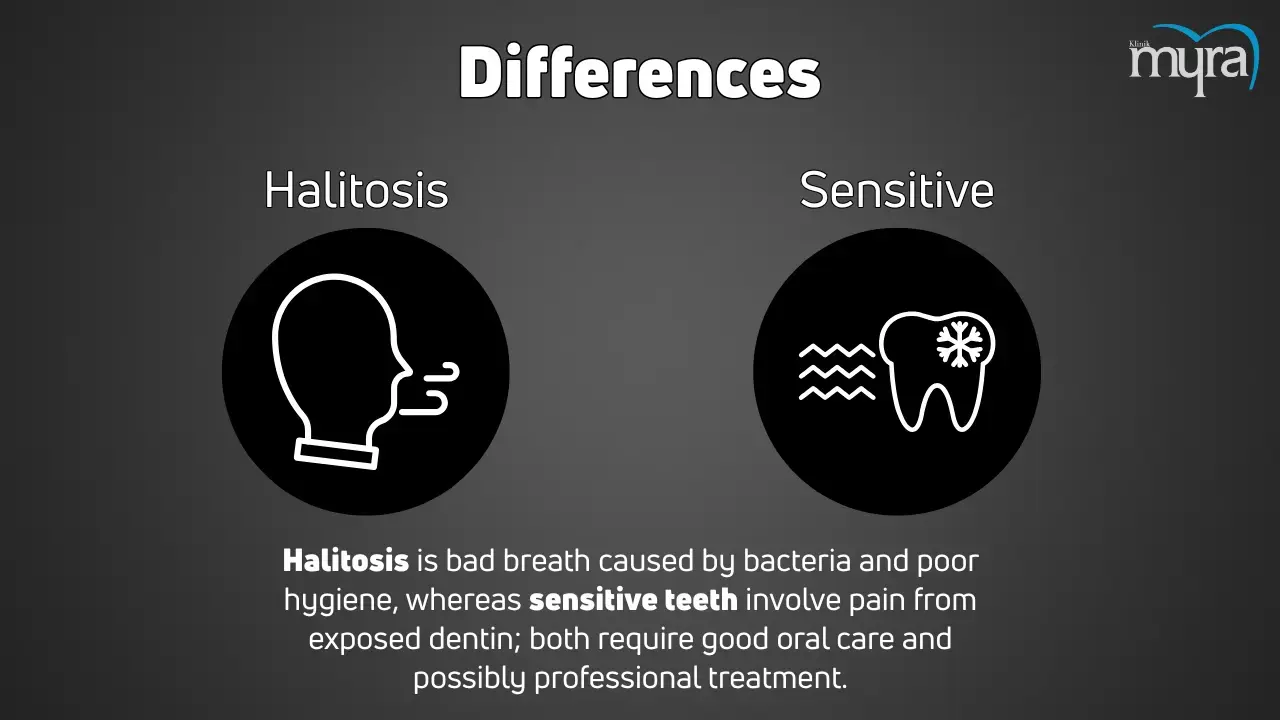Bad breath (halitosis) is a common condition that impacts social interactions and self-esteem. Bad breath arises from various sources, including poor oral hygiene, certain foods, and underlying health conditions. Understanding the symptoms, treatment options, causes, and related conditions is essential for effectively managing and preventing bad breath.
Symptoms of bad breath include a persistent unpleasant odour, dry mouth, a sour or bitter taste, a white coating on the tongue, thick saliva, and the constant need to clear the throat. Morning bad breath and a burning tongue are common indicators of decreased saliva production during sleep.
Treatment for bad breath involves maintaining good oral hygiene. Treatments include brushing the teeth with fluoride toothpaste twice daily, flossing daily, and using antimicrobial mouth rinses. Regular dental checkups are crucial for identifying and addressing underlying dental issues such as gum disease or extensive plaque buildup. Home remedies like drinking plenty of water, consuming yoghurt, and chewing parsley or fennel seeds help manage bad breath. Tongue scraping and proper cleaning of dental appliances are additional steps to keep bad breath at bay.
Bad breath has diverse causes. Poor oral health care, including inadequate brushing and flossing, leads to food particles in the mouth, which tooth decay and cause odour. Garlic and onions are among the foods that cause a short-lived effect on breath. Dry mouth, where saliva production is decreased, results from medications or breathing through the mouth. Tobacco products and underlying health conditions such as respiratory infections, diabetes, gastrointestinal disorders, and liver or kidney diseases contribute to halitosis.
Similar conditions to lousy breath include dandruff, scalp psoriasis, folliculitis, seborrhoeic dermatitis, trichotillomania, and alopecia areata. The conditions, like halitosis, are embarrassing and affect personal interactions. They require proper hygiene and medical treatment for effective management. Bad breath and these hair problems are signs of deeper health problems that need fixing.
Research on halitosis has provided valuable insights into its causes, diagnosis, and treatment. The study "Halitosis in the Absence of Oral Causes: Recent Research on the Aetiology of Non-Oral Origins of Halitosis," conducted by Susan M. Badanjak, aimed to identify and classify the causes of extra-oral halitosis and emphasise the importance of multidisciplinary treatment.
Another study, "Halitosis: From Diagnosis to Management" by Bahadır Uğur Aylıkcı and Hakan Çolak, explored the multifactorial origins of halitosis, emphasising the need for proper oral care. "Clinical Examination of Subjects with Halitosis" by AC Donaldson, MP Riggio, HJ Rolph, J Bagg, and PJ Hodge developed a detailed clinical protocol for halitosis, highlighting organoleptic assessment's importance in clinical practice.

What are the Types of Bad Breath?
The types of Bad Breath are listed below.
- Sweet or Fruity Smell: Breath that has a scent reminiscent of ripe fruits or sugary sweetness.
- Rotten or Fetid Smell: Breath that emits an odour similar to rotting garbage or decaying matter.
- Nail Polish Remover Smell: Breath with a sharp, chemical scent similar to acetone or nail polish remover.
- Sour Smell: Breath that carries an acidic, tangy scent akin to partially digested food or sour milk.
- Faeces Smell: Breath with a foul odour similar to faeces or sewage.
- Ammonia or Urine Smell: Breathe with a spicy, ammonia-like scent reminiscent of urine.
- Musty Smell: Breath with a stale, damp, and mouldy scent.
- Maple Syrup Smell: Breath with a sweet, sugary scent similar to maple syrup or caramel.
- Sweaty Feet Smell: Breathe with a sour, pungent odour resembling sweaty feet or dirty socks.
- Fishy Smell: Breath with a strong, unpleasant odour similar to rotting fish.
- Boiled Cabbage Smell: Breath with a sulphurous, cooked vegetable scent similar to boiled cabbage.

What are the Symptoms of Bad Breath?
The symptoms of Bad Breath are listed below.
- White Coating on the Tongue: A white film at the back of the tongue harbours odour-causing bacteria.
- Dry Mouth: Inadequate saliva production leads to a parched feeling in the mouth and a sticky, dry sensation.
- Build-up Around Teeth: Accumulation of plaque or tartar on teeth, contributing to bad breath.
- Post-nasal Drip: Mucus dripping down the back of the throat from the nose, causing an unpleasant smell.
- Morning Bad Breath and Burning Tongue: Foul breath upon waking and a burning sensation on the tongue.
- Thick Saliva and Constant Need to Clear Throat: Saliva that feels thick and sticky, with a persistent urge to clear the throat.
- Constant Sour, Bitter, or Metallic Taste: A lingering unpleasant taste in the mouth described as sour, bitter, or metallic.

What are the Causes of Bad Breath?
The causes of Bad Breath are listed below.
- Certain Foods: Foods such as garlic and onions are absorbed into the bloodstream and affect breath until they leave the body.
- Poor Oral Health Care: Lack of regular brushing, flossing, and dental exams leads to food particles in the mouth, breeding bacteria that cause odour.
- Improper Cleaning of Dentures: Dentures not properly cleaned collect bacteria, fungi, and food particles, causing bad breath.
- Odour-causing Bacteria on the Tongue: Bacteria on the back of the tongue produce smelly sulphur compounds by interacting with amino acids in foods.
- Periodontal Disease: Gum disease that results in bad-smelling breath and an unpleasant taste in the mouth, requiring immediate professional care.
- Dry Mouth (Xerostomia): A decrease in saliva production prevents the mouth from cleansing itself, allowing debris and food particles to cause odour.
- Tobacco Products: Products such as cigarettes, cigars, and smokeless tobacco stain teeth, irritate gums, and increase the risk of diseases, contributing to bad breath.
- Health Conditions: Conditions like respiratory infections, chronic bronchitis, postnasal drip, chronic sinusitis, diabetes, gastrointestinal disorders, and liver or kidney disorders cause bad breath.

What are the Treatments for Bad Breath?
Treatments for Bad Breath are listed below.
- Gum Disease: Chronic gum disease leads to bad breath. A dentist or periodontist performs a periodontal cleaning to remove bacteria, tartar, and plaque from the gumline.
- Extensive Plaque Buildup: A dentist or periodontist suggests an antimicrobial mouth rinse and tongue brushing to get rid of bacteria that cause bad breath if there is a lot of plaque buildup.
- Health Condition: Treating an existing health condition diagnosed by a healthcare provider to eliminate bad breath caused by that condition.
- Poor Oral Health Care: A dentist treats bad breath due to not caring for the gums and teeth.
Can Bad Breath Be Treated At Home?
Yes, bad breath can be treated at home using various remedies and good oral hygiene practices. Proper dental hygiene is essential in safeguarding against and addressing bad breath, as it is the most common cause. Plaque buildup is prevented, and oral health is maintained by flossing daily and brushing teeth for two minutes each time with fluoride toothpaste. Tongue scraping removes bacteria that accumulate on the tongue and cause foul odours.
Home remedies such as parsley, pineapple juice, and yoghurt help manage bad breath. Chewing fresh parsley leaves after meals or taking parsley supplements helps deodorise the breath due to its high chlorophyll content. Drinking pineapple juice or munching on pineapple slices after meals improves breath. Yoghurt contains healthy bacteria that combat harmful bacteria in the mouth, and eating plain, nonfat yoghurt daily has been shown to reduce bad breath.
Hydration is crucial in preventing dry mouth, which causes terrible breath. Drinking water throughout the day encourages saliva production, keeps the mouth clean and reduces bacterial growth. Other remedies, like drinking milk to neutralise odours from strong-smelling foods, chewing fennel or anise seeds, and eating oranges to increase saliva production, help. Homemade mouthwashes with baking soda or vinegar diminish bacteria in the mouth. The methods reduce unpleasant breath. The patient must see a doctor to rule out more serious medical issues if they continue or worsen.

What are the Research about Halitosis?
The research about halitosis focuses on the causes, diagnosis, and treatment of the dental problems. The study "Halitosis in the Absence of Oral Causes: Recent Research on the Aetiology of Non-Oral Origins of Halitosis," conducted by Susan M. Badanjak, aimed to identify and classify the causes of extra-oral halitosis, describe assessment and differential diagnosis techniques, and provide treatment and management strategies. The review highlighted the importance of a multidisciplinary approach to treating extra-oral halitosis to improve health. The research highlighted the importance of accurate diagnosis and effective treatment for halitosis by examining articles from databases like MEDLINE, CINAHL, and Scopus. It highlighted the prevalence and impact of halitosis.
Another significant study, "Halitosis: From Diagnosis to Management," by Bahadır Uğur Aylıkcı and Hakan Çolak, explored the multifactorial origins of halitosis, emphasising that 90% of cases stem from the oral cavity. The study detailed various etiological factors, including poor oral hygiene, periodontal disease, and tongue coatings, and discussed methods for diagnosing and managing halitosis. The research aimed to comprehensively understand halitosis's prevalence, causes, and treatment approaches, highlighting the importance of clinical examination and proper oral care.
The study "Clinical Examination of Subjects with Halitosis" by AC Donaldson, MP Riggio, HJ Rolph, J Bagg, and PJ Hodge created and used a detailed clinical protocol to screen and evaluate people who complained of bad breath. The cross-sectional study recruited subjects through advertisements and conducted clinical examinations, including organoleptic assessments and Halimeter® readings. The study aimed to establish a reliable standard for defining and diagnosing halitosis, identifying that organoleptic assessment is a valuable tool in clinical practice. The research highlighted the challenges in recruiting and diagnosing halitosis patients, emphasising the need for comprehensive clinical protocols.
What are the Differences between Halitosis and Sensitive Teeth?
The difference between halitosis and sensitive teeth lies in their causes, symptoms, and underlying issues. Halitosis is caused by a buildup of bacteria in the mouth due to poor oral hygiene, food remnants, or plaque buildup. Halitosis is characterised by an unpleasant odour emanating from the mouth. Sensitive teeth are defined by a sharp, temporary pain or discomfort when exposed to certain stimuli, such as hot, cold, sweet, or acidic foods and drinks, along with brushing and flossing. The condition occurs due to the exposure of the dentin layer beneath the enamel, which contains tiny tubules leading to the tooth's nerve endings.
The causes and treatments for halitosis and sensitive teeth differ. Halitosis is caused by the breakdown of food particles and the presence of odour-causing bacteria in the mouth. It is effectively managed through improved oral hygiene practices, such as regular brushing, flossing, and mouthwash, along with lifestyle changes like staying hydrated and avoiding foods contributing to bad breath. Sensitive teeth result from the physical exposure of the tooth's inner layers due to factors like worn enamel, receding gums, or dental procedures. Treatments for sensitive teeth include desensitising toothpaste, fluoride treatments, dental fillings, root canals, or gum grafting to cover exposed roots and reduce sensitivity.
The effects on oral health and the necessity of regular dental care are comparable for halitosis and sensitive teeth. Halitosis and sensitive teeth cause discomfort and affect a person's quality of life. They highlight the importance of maintaining good oral hygiene and seeking professional dental advice to address underlying issues. Regular dental check-ups help prevent and manage the conditions, ensuring oral health. Individuals reduce discomfort and improve their dental well-being by effectively understanding and treating these conditions.






